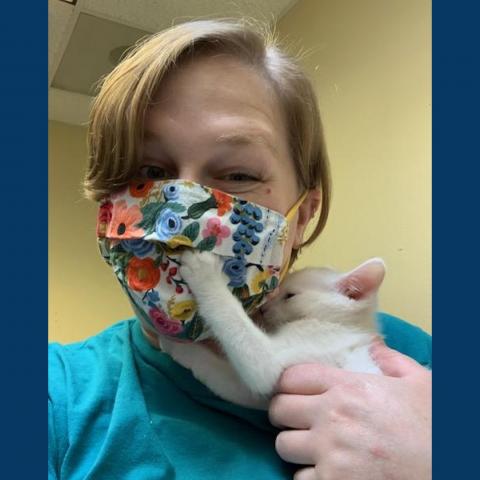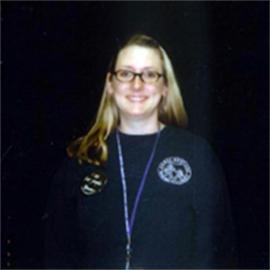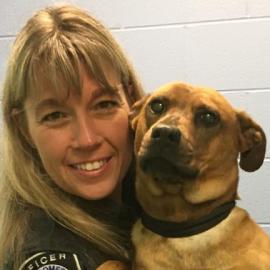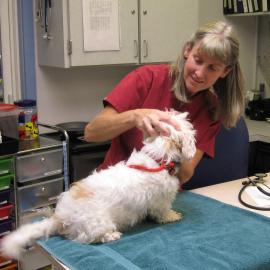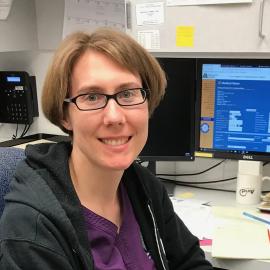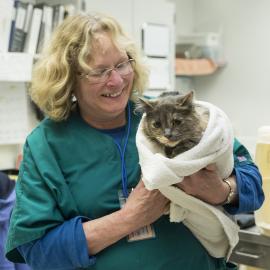Staff Spotlight- Andrea B. - 5 Years
Andrea B. has always enjoyed working with animals, being outside, and having physical and active jobs. Andrea found meaning as an Animal Care Tech 2 at Multnomah County Animal Services (MCAS) working to make a difference for pets and their people.
Andrea grew up in the bay area of California, and moved to Portland “on a whim” after graduating. She found a seasonal position with Washington County in their Public Health Services Department in Vector Control. Her job was to monitor the mosquito population, studying different species and where they were located. “I would drive around to different locations and capture larval samples, and collect big bags of adult mosquitos around the county, then send them out for testing,” Andrea says. “It was the perfect job to spend time outdoors and see new places.”
After her seasonal position ended, Andrea found a position at a local doggy daycare, and eventually began managing their playgroups. In her role, Andrea learned a lot about dog handling, canine body language, and their behavior. It was a helpful precursor for her current role on the Animal Care team at MCAS.
In the Animal Care Technician 2 role, Andrea provides the initial intake of dogs, assesses behavior throughout their stay, and implements behavior plans for animals who may be struggling. She also serves as an adoption counselor, helping potential adopters find the right pets for their lifestyle and needs.
“I was looking for something that gave a little more back to the community, and that’s what got me really excited about this position at MCAS. We get to do work that makes a big difference to the animals and to their people. I also found that I really love animal behavior. In my role, there’s a lot of educational opportunities where I can help people with their pets, or help them find the right pet to adopt. I also get a lot of animal behavior work, and one-on-one time with animals.”
Three Roommates, One Dog
Andrea says there are definitely some experiences that she remembers more than others. She remembers when a group of three young-adults came to MCAS looking for a dog they could adopt together as roommates. “They initially picked a dog that may not have been a good fit for them. I talked them through some of the considerations they would need to make for continuity of care, their availability, and cost of care. They initially seemed frustrated that I was saying no to adopting this particular dog. But they came back a week later, and said ‘we think we found a better match for a dog to adopt based on what you told us, and we would like to talk with you about it.’ I was just really impressed that they were able to listen, take stock of their needs, abilities, and resources, and respond with a better solution. It was refreshing that they wanted to come back with a more informed approach and see what would work for them. In the end, they were able to find a much better match for what they wanted, and to meet the dog’s needs.”
Education For Quality of Life
“I remember when a community member came in looking to adopt a dog as a companion for his Rottweiler. They came in so that his dog could meet the dog he was interested in adopting. While talking about his dog, and after hearing some of the stressors and behaviors his dog was experiencing, I had to tell him that I didn’t think his dog would enjoy having another dog in the home. Instead of moving forward with an adoption, I worked with the Canine Behavior Specialist to provide him with some educational materials for resource-guarding. He was also walking his dog on a prong collar, so I asked him if he had ever used a harness before. He was interested, so I actually found a harness, and we took his dog for a walk around the parking lot to see how it felt. He said ‘oh, this is actually easier to handle!’ and bought the harness. In the end, he didn’t adopt a dog, but he walked away with some resources to help make life better for him and his dog.”
Pet Retention
“In the animal welfare world, we focus a lot on adoptions,” Andrea says. “Everybody loves to share and hear adoption stories. They truly are inspiring and wonderful, and we’re so happy when animals find new homes. But I believe our most important work happens more discreetly, behind the scenes, helping community members enduring hardships. For me, the most meaningful experiences I’ve had involve helping pet owners to keep their animals, preserving those important bonds.
“Several weeks ago, a community member newly experiencing houselessness came in to the shelter with his dog. He was really emotional, and asked if he could surrender his dog, but we could tell it wasn’t something he wanted to do. So we asked him if there was anything we could do to help him keep his dog.
“His back window in his car was broken, and he was having trouble containing the dog. As a temporary fix, we got some cardboard and tape, and made a makeshift barrier. We also gave him a crate. In the beginning, I think he just thought that we would just take his dog, but with some problem-solving and some low cost solutions, we were able to help him keep his dog, which is what he wanted too.
“Above all else, we would love to help people keep their pets. Our most important work is helping pets and people in crisis. We have emergency pet food assistance available, and we do our best to support community members in crisis situations, including eviction, hospitalization, incarceration, and other emergencies.
Staff Support & Interactions
Andrea has always worked closely with Jodi, another Animal Care Tech 2 working with dogs on her side of the shift. “Jodi has extensive dog behavior & training education, and a broad knowledge and experience. For me coming into this role, but with a different background, Jodi was invaluable in helping me learn more animal-welfare specific knowledge. She helped me to be more comfortable with different scenarios. Probably the most helpful and healthy trait of our dynamic is that I can always talk things through with her, bounce ideas around, and get her opinions. One of the things I value about Jodi is that we can professionally disagree with each other, but talk openly and honestly about how we feel about something and why. Understanding each other's perspective helps us move forward and form common goals.”
Canine Behavior Plans
“I was here when we implemented a new system to work on animal behavior and enhanced enrichment,” Andrea says. “We started dedicating more staff time for intentional behavior management, and behavior plans. We actively work to address issues of fear, anxiety, and stress (FAS). I got to be a part of the program development, and effective ways to track progress. For each individual animal, we work through ways we can help mitigate circumstances that are difficult for them. It applies to any animal in the shelter- dogs, cats, rabbits, any shelter resident that may be struggling.”
Andrea has a soft-spot for the long-term “rowdy” shelter residents, and their photos still adorn her work locker long after they’ve gone. It’s easier to bond with them over time, but ultimately the goal is to move them to a positive outcome as soon as possible. “Even when we’re doing the best we can, the shelter is no substitute for a home, and it can be a stressful place for animals,” Andrea says.
Andrea remembers working on a behavior plan with a dog named Rhonda, whose behavior challenge was that she was constantly fixated on having something in her mouth. “That something was most often the leash,” Andrea says, “but sometimes she tried to bite the leash, and your hand was there. Molly, a volunteer, and I would work really hard to advocate for her, and to find an outcome. Our plan was to work on changing her behavior so that when she saw the leash, she would move to put a toy we were holding out in her mouth instead. It was easy in theory, but more difficult in practice. Molly even fostered her for a little while to work on it. In the end, we were able to find an adopter for Rhonda, and we never heard from her again,” which is Andrea’s version of the joyful trope of riding off into the sunset, or living happily ever after. “Well, that’s not true,” she says, “Molly still keeps tabs with the adoptive family and sends us updates- she’s doing well!”
Thank you, Andrea, for your five years of service to the pets and people of Multnomah County in your role as an Animal Care Tech 2.

